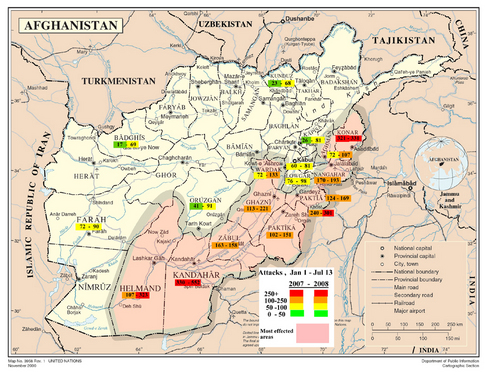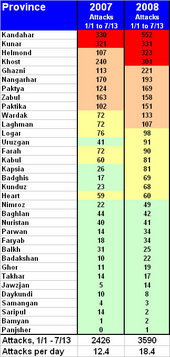By Chris Radin and Bill Roggio
Afghanistan has seen its worst bout of violence since the US overthrew the Taliban government in 2002. Taliban-related attacks and incidents have skyrocketed as the Taliban seeks to destabilize and de-legitimize the weak Afghan government and break NATO’s will to fight a protracted counterinsurgency campaign.
The number of Taliban-related incidents per day has jumped by almost 50 percent, according to data compiled by Vigilant Strategic Services Afghanistan. The data compares the Taliban-related incidents from the Jan. 1 to July 13 time periods in 2007 versus 2008.
Afghanistan experienced 18.4 attacks per day in 2008 compared to 12.4 in 2007. Much of the violence can be traced back to Pakistan’s lawless border region, where the Taliban openly control wide swaths of territory.
More than two-thirds of the Taliban-related violence has occurred in nine of Afghanistan’s 34 provinces. Each of the nine provinces borders Pakistan and seven of them border the volatile tribal areas where the Taliban and al Qaeda have a de facto sanctuary and maintain more than 100 camps.
While NATO and Afghan forces have killed an estimated 7,000 Taliban fighters this year, the Taliban have demonstrated the capacity to recruit new fighters. These recruits are often trained in the Pakistani camps before being sent across the border to strike at NATO and Afghan forces.
In the southern provinces of Helmand and Kandahar, the violence has more than doubled. Kandahar and Helmand are two of the three most violent provinces in Afghanistan (first and third, respectively). In neighboring Uruzgan, violence has more than doubled.
Taliban-related incidents have more than tripled in Helmand province (323), although much of the violence in Helmand may be attributed to a US Marine Corps offensive that began this year. The US Marines stated they killed more than 400 Taliban fighters in the southern province since arriving this spring.
Attacks in Kandahar have nearly doubled (553) since last year. Two recent attacks highlight the deteriorating security situation in the province.
The Taliban conducted two successful high-profile attacks in Kandahar in July. Taliban forces overran the Arghandab district and held it for several days after conducting a bold jailbreak in the heart of Kandahar city. More than 1,100 prisoners, including 400 mid- and low-level Taliban operatives, were freed. Few of those freed have been rearrested or killed.
The Taliban are said to control six of Kandahar’s 16 districts, according to a US assessment. The Canadian Army and the Afghan government are focusing their efforts on the most populous districts, and control four, including Kandahar city, Arghandab, Spin Boldak and Daman. The Taliban control remote, rural districts where Canadian and Afghan forces have pulled back. The remaining six districts are classified as contested or locally controlled.
The eastern provinces bordering Pakistan’s tribal areas account for seven of the remaining top nine most violent provinces. Kunar remains the second most dangerous province (331 incidents) but attacks have remained steady. Attacks increased by more than 20 percent in Khost (301) and doubled in Ghazni (221). Attacks have increased by between 20 and 50 percent in Nangarhar, Paktia, Paktika, Wardak, Laghman, and Logar.
With more resources and a safe haven in northwestern Pakistan, the Taliban, al Qaeda, and allied terror groups have launched numerous attacks on US and Afghan outposts in the eastern provinces. The Taliban are attempting to destabilize the eastern region and overrun Afghan government centers and Coalition bases. The vast majority of these battles end badly for the Taliban. Scores of Taliban their fighters are often killed and no or few US and Afghan casualties are taken.
Outside of the South and East, there has been a rise in attacks in regions that were relatively quiet one year ago. Attacks tripled in Kapisa, Badghis, and Kunduz, and are up in the southwestern provinces of Nimroz and Farah.










15 Comments
The country hasn’t known peace since the Soviets came in 1979.
I’m interested to see what Petraeus has in mind to do here. There was an article on Michael Yon’s site that had a report written by retired Gen. Barry McCaffrey who called for a huge increase in aid to the Afghan military, especially their air components. Sounds good, but that’s going to take a long time to get working, considering that a huge portion of their population literally can’t read…pilot school is going to be a bit further down the road then.
We’re going to need a surge of not just troops and equipment, but also a micro-finance surge. The huge World Bank or IMF grants simply don’t work. Portions of money get siphoned off from corruption, and other portions are whittled away through bureaucracy. Micro-finance gets right to the source and empowers local entrepreneurs.
Thanks for the map LWJ and all you do.
The map shows you how violent and volatile Afghanistan has become these past couple years. I wonder if Petraeus can stabelize Afghanistan, and Pakistan like he did with Iraq.
By the way, I’m new to the LWJ and I am looking forward on taking part in more of these discussions.
It all comes down to Pakistan. I don’t pretend to be smart enough to have a solution to that situation. But something will eventually have to be done to deny the Taliban the ability to retreat into Pakistan every winter and rearm/equip/recruit.
Just to clarify I am a different Alex than the one the first post here on the 5th, I guess I’ll use a different name to avoid confusion heh
Alex,
Thank you for referencing McCaffrey’s report. When US Pres. candidates endorse sending troops to A’gan I wonder if there’s any informed projection of the long view? Who will provide the vast numbers of troops required? Or will we go in with any long view? Who else will ramp up long term investment of troops?
Alexes,
I am of the view that the vast majority of the violence in Afghanistan stems from the problems in Pakistan. Alex #2 is correct that the solution to this problem is extremely difficult. I wrote about this last October, the answer is someone, preferably the Pakistanis, need to police up their mess:
https://www.longwarjournal.org/archives/2007/10/crunch_time_in_pakis.php
This will come at an extraordinary cost to whoever takes on the task.
The way the P-stani gov. is handling this mess is like a bad joke. Every insurgency needs a base of ops., and they have it better than ever in P-stan. The P-stani’s continue to backpeddle, appease, and are of no help to the US. P-stan is sliding towards islamic fundamentalism, it may be only a matter of time until they come to power. The US has to find another route for logistics very soon, I believe this 1 issue is preventing US warplanes from delivering a massive strike to destroy the 100 camps that were only 30 or so 3 months ago. For the Deputy Dir., CIA, and Admiral Mullen to go to P-stan and confront them about thier ISI and the lack of participation from the Army, there must have been hard evidence. Sooner or later, we will be knocking heads with the p-stani’s. Find another route, quick.
How is an ‘attack’ defined?
Rhyno327
As far as I can tell, there are no good alternative supply route. One way or another, all other routes have major problems. That is a fundimental problem. (I would love to be proven wrong though….)
So, no matter what issues we have with Pakistani government, military or intel services, we have no alternative but to stay on good terms with them.
“Would it be feasible to set up shop in one of the former Soviet republics that border Afghanistan to the north and run our supplies overland from there?”
Mike:
Lets look at the alternatives
Alternative1:
By sea to Georgia
By road though Georgia and Azerbizan.
By sea accross the Caspian to Turkmenistan
By road through Turkmenistan to Herat, Afghanistan.
By road to Kabul
Twice the road distance, a sea passage, across 3 countries with 3 load transfers along the way.
Alternative2:
By sea to Rostov, Russia
By road across Russia, Kazakstan and Uzbekistan to Mazir el Sharif.
By road to Kabul
4 or 5 times the distance across 3 (not paticularly friendly) countries.
Alternative3:
By sea to Iran…..
Well thats a non starter
As far as I can tell, thats all there are.
The Thunder Run has linked to this post in the blog post From the Front: 08/06/2008 News and Personal dispatches from the front and the home front.
Euro 2.0
Below is the definition of “Attacks” in Iraq. The same definition applies to Afghanistan.
The term “attacks” refers to all incidents reported to Multi-National Force-Iraq (MNF-I) through daily Significant Activity Reports. It includes known attacks on Coalition forces, Iraqi Security Forces, the civilian population, and infrastructure. It does not include criminal activity, nor does it include attacks initiated by Coalition or Iraqi Security Forces. The complexity and effectiveness of these attacks vary. They can range from a single insurgent firing a single shot causing no casualties to a highly coordinated complex attack using two or more weapon systems. For IEDs, attacks include both IEDs that explode and IEDs that are found and cleared before they can explode.
Pretty clearly, we cannot afford to have Pakistan close the supply routes through Pakistan. But what about the Taliban closing them one of these days.
That Afghan ambush
Danger Room has a good overview. It seems that this ambush has solified the fact that Afghanistan is sliding backwards. The New York Times provides are few reasons this is happening.
The attacks were part of a sharp escalation in fighting as insurgents…